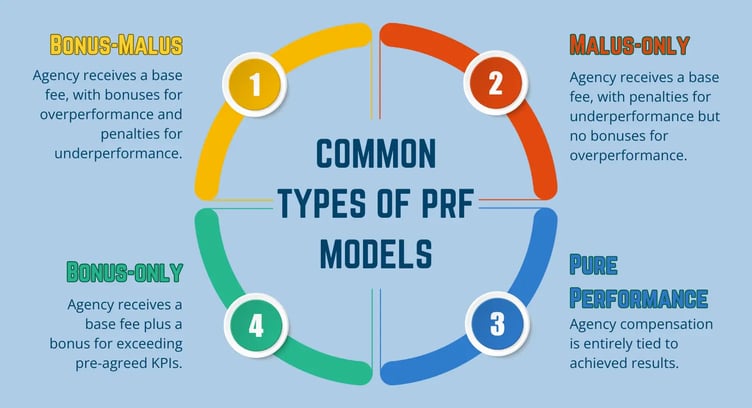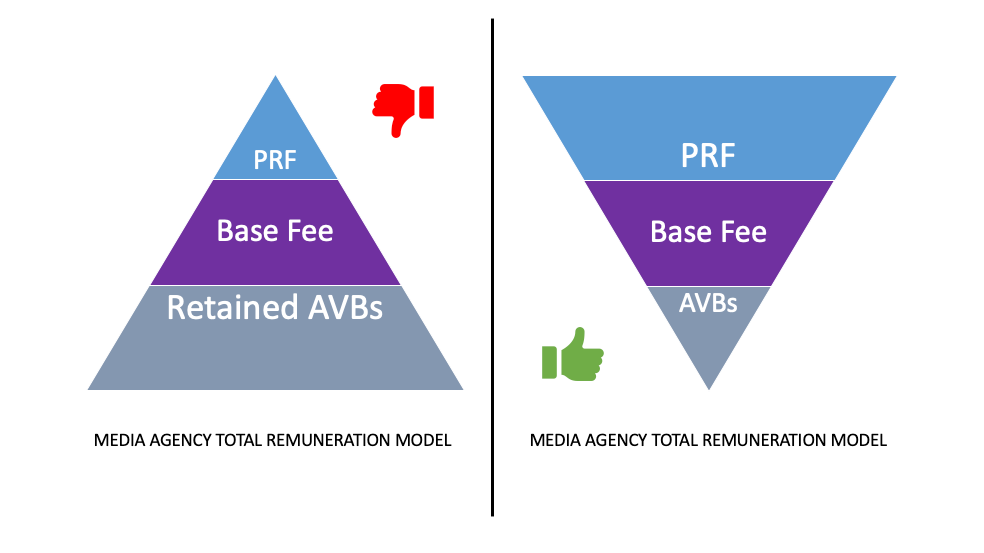Running a successful Performance Related Fee (PRF) scheme is a powerful way to align the interests of advertisers and media agencies, driving better results and fostering more collaborative partnerships.
From our research however, we found that two-thirds of media agency contracts do have a PRF included in the remuneration model. But only a third of these PRF schemes were suited for purpose.
Too often, we see PRF schemes where a bonus is paid to the media agency for simply delivering what is expected of them, rather than rewarding exceptional performance. A bonus should only be paid when the agency delivers above and beyond expectations, not merely for meeting them.
With our extensive experience as a global media consultancy, we have identified the key components and best practices that make up a win-win PRF scheme for both advertisers and media agencies.
Our proprietary PRF scheme has been designed to create a fair, balanced, and mutually beneficial relationship between advertisers and media agencies, while driving innovation, transparency, and shared success.
In this article, we'll reveal the secrets of designing and implementing a successful PRF scheme that benefits both parties.
What is a PRF Scheme?
A Performance Related Fee (PRF) scheme is a compensation model that ties a portion of the media agency's remuneration to the achievement of agreed-upon performance metrics or key performance indicators (KPIs).
These KPIs can range from media cost savings and service delivery to brand awareness and sales growth. By linking agency compensation to tangible results, PRF schemes create a shared sense of accountability and incentivise agencies to deliver their best work.
Unlike traditional compensation models, such as fixed commissions or retainer fees, PRF schemes prioritise outcomes over outputs, ensuring that agencies are rewarded for the value they create rather than the hours they bill.

Benefits of PRF for Advertisers
For advertisers, PRF schemes offer a range of compelling benefits:
- Alignment of incentives: By tying agency compensation to the achievement of advertiser objectives, PRF ensures that agencies are fully invested in delivering results that matter to the client.
- Increased innovation and quality: With financial rewards on the line, agencies are motivated to bring their best ideas and expertise to the table, pushing the boundaries of creativity and effectiveness.
- Media transparency and competitive pricing: PRF schemes often include provisions for media transparency, allowing advertisers to see exactly where their budget is being spent and ensuring they receive competitive rates.
Benefits of PRF for Media Agencies
Media agencies also stand to gain significantly from well-designed PRF schemes:
-
Increased revenue and profitability: By delivering exceptional results, agencies can unlock additional revenue streams and boost their profitability.
-
Long-term, strategic partnerships: PRF schemes encourage agencies to think beyond short-term tactics and invest in understanding their clients' businesses, leading to more strategic and valuable long-term partnerships.
-
Showcase expertise and value: PRF provides a platform for agencies to demonstrate their unique capabilities and the tangible value they bring to their clients' businesses.
Designing an Effective PRF Scheme
Creating a PRF scheme that works for both advertisers and agencies requires careful planning and collaboration.
Advertisers and agencies should work together to define KPIs that are meaningful, measurable, and aligned with the advertiser's business objectives.
KPIs should be specific, achievable, and based on factors that the agency can directly and indirectly influence. A mix of both bonus and malus mechanisms can ensure fairness and accountability.
To truly motivate agencies, the PRF component should represent a significant portion of their total remuneration for it be truly effective. If the PRF is too small, it won't incentivise the agency enough, or put the agency profit margin at risk. The agency remuneration pyramid needs to be reversed (see chart below):

Potential Challenges
While PRF schemes offer many advantages, there are also potential challenges to consider:
- Balancing creativity and performance: Agencies may feel pressure to prioritise short-term performance over long-term brand building. Advertisers should ensure that KPIs include a mix of both sales-driven and brand-focused metrics.
- Fair and unbiased design: PRF schemes designed solely by either the advertiser or the agency may be seen as biased. Using a neutral third party, such as a media consultancy, can help ensure a balanced approach.
- Maintaining control and flexibility: Advertisers may worry about losing control over their campaigns. Regular communication and clearly defined roles and responsibilities can help maintain a healthy balance.
Overcoming these challenges requires open and honest communication between advertisers and agencies, as well as a willingness to continuously review and refine the PRF scheme based on learnings and evolving business needs.
In Conclusion
As the advertising industry continues to evolve, PRF schemes are poised to play an increasingly important role. More and more advertisers across various industries are recognising the benefits of PRF and implementing these models in their media agency partnerships.
They represent a powerful tool for aligning the interests of advertisers and media agencies, driving better results, and fostering more collaborative and transparent partnerships. By designing PRF models that are fair, balanced, and focused on shared success, both parties can unlock significant benefits and build relationships that stand the test of time.
At Abintus, we have seen the transformative impact of well-designed PRF schemes firsthand. We strongly encourage advertisers and agencies to explore this approach and to work together in creating PRF models that drive mutual success.
And if you need guidance in navigating this process, our team of experts is here to help. Together, we can harness the power of PRF to drive better outcomes for all stakeholders in the advertising ecosystem.
Additional resources related to this topic:
- Reward Agency Excellence with PRF Makeover
- How a powerful PRF can maximise your media agency’s performance
--------------------------------------------------------------------------------
About the Author
 Philippe Dominois is co-founder and CEO of Abintus Consulting, and Head Coach at the Abintus Academy. He has over 25 years of international media experience, having worked on the media agency side, client side, and media auditing side throughout his career. Philippe has authored hundreds of articles over the years that focus on media management best practices.
Philippe Dominois is co-founder and CEO of Abintus Consulting, and Head Coach at the Abintus Academy. He has over 25 years of international media experience, having worked on the media agency side, client side, and media auditing side throughout his career. Philippe has authored hundreds of articles over the years that focus on media management best practices.
Media Auditing Services: Click Here
Agency Pitch Management Guide: Click Here
Free Agency Contract Assessment: Click Here
Free Media Training for Advertisers: Click Here


